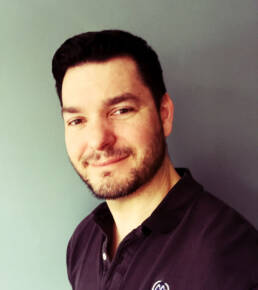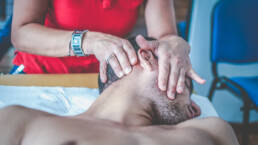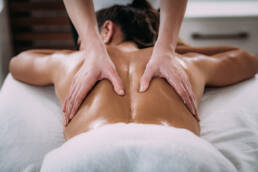Creaky knees, stiff hips, and sore shoulders are only a few of the common orthopedic issues that you might encounter. Since orthopedic medicine deals with correcting bone and muscle issues, there are many problems that can fall into this category.
As a result, orthopedic massage encompasses an extensive range of techniques. The one commonality is that the purpose behind these techniques is to preserve, enhance or restore regular use of the muscle or bone in question.
For example, orthopedic massage for a knee issue would focus on the quadricep muscles and their supportive structures, such as the anterior cruciate ligament, among others. The thinking behind this general course of action is that the joint will function properly when the soft tissues that support it are healthy and supple.
Some Common Orthopedic Massage Techniques
Since orthopedic massage is designed to work for a wide range of conditions, it includes a broad range of techniques. Below are some of the ones you can expect during an orthopedic massage therapy session.
Friction and Stretching
Friction forms the backbone of many massage techniques. It is very important because friction warms the muscles. Without the warmth provided by friction, your muscles would more easily tear or become injured.
Stretching is something that you can do on your own, but when you’re in the hands of an experienced, skilled orthopedic massage therapist, your muscles can benefit from safe, controlled, and proper stretching throughout their range of motion. Since you’re free to relax during a massage session, the therapist can help safely get good stretching from your muscles.
Effleurage and Petrissage
Effleurage and petrissage are two hallmark movements of massage in general that have fantastic benefits for orthopedic applications. Effleurage encompasses using light pressure to glide along the muscles in circles using the fingertips, thumbs, and palms. It is very relaxing and is useful for boosting circulation and lymphatic system activity.
In many ways, petrissage represents the opposite end of the massage spectrum. Petrissage involves deep, kneading strokes using the palms, fingers, and thumbs. Your tissues might be wrung, rolled, kneaded, or squeezed. Petrissage also boosts the circulation. It also stretches muscles and increases their range of motion to enhance recovery.
Myofascial Release
Myofascial release is a popular orthopedic technique. The myofascia is made of the sturdy membranes that house the muscles. When the myofascia become tight from injury or disease, they become painful and limit movement.
Myofascial release’s primary purpose is to halt or reverse this process, freeing you to move more efficiently and with less pain. During a myofascial release-focused orthopedic massage, you can expect lots of firm pressure and targeted stretching.
Lymphatic Drainage
Lymphatic drainage is an orthopedic massage technique that matches its name. During a lymphatic drainage orthopedic massage, your therapist initially focuses on carefully assessing areas of your body near your lymph nodes. If these areas have swollen tissue, then the chances are good that you have a lymphatic drainage issue.
If your therapist has determined that you have a lymphatic drainage issue, then they examine your body for a nearby area with adequate lymphatic drainage. Once they’ve located this area, your therapist will physically move the lymph to the adequately draining area so that the lymph can be appropriately filtered, removing waste products from your body. Reducing swelling from excess fluid reduces tight, painful skin.
Some Important Benefits
Although orthopedic massage includes many different techniques, they all have the following three key benefits:
- Pain Reduction
- Movement Promotion
- Injury Prevention
Less Pain
One of the best benefits of this form of massage is how it can help you better manage pain. Since orthopedic massage therapy techniques cover a range of styles, you can find a technique that helps relieve your pain and make you feel your best.
In orthopedic massage, this is critically important because some techniques might involve more force than others or types of touch that don’t feel helpful to your body. Sometimes, a particular treatment might have glowing reviews but do nothing for your pain. During an orthopedic massage treatment, you’re the final authority on how your body is treated.
More Movement
A natural result of less pain is the ability to move more frequently and more freely. This is more than just common sense. It is backed by scientific research. A recent study revealed that functional orthopedic massage helped individuals recovering from total hip replacement surgery to improve their range of motion, gait speed, and balance.
A total hip replacement surgery is a dramatically life-altering procedure. The movement recovery that orthopedic massage provides can encourage increased circulation, tissue oxygenation, and additional healing.
Reduced Risk
Whether you’re recovering from surgery or working on perfecting your golf swing, doing everything you can to avoid an injury is critically important. Orthopedic massage can help maintain and recover the tissues needed to ensure you can participate safely in your chosen activity. This helps you avoid further injury down the road.
Experience Orthopedic Massage
Whether you’re a promising college athlete who might have a professional sports career ahead of them or a grandparent hoping to rehab your knee to keep up with your grandchild, we’re confident that orthopedic massage can help you. If you’d like to experience all that orthopedic massage can do to enhance your comfort and performance while helping to prevent future issues, please book an initial appointment online. We’d love to help you feel your best by benefitting from orthopedic massage.

With unique treatment plans tailored specifically to each individual, our goal is to offer a comprehensive approach to healing and reducing pain. We pride ourselves on taking a holistic approach to massage therapy for pain and are committed to providing the highest quality care. If you’re looking for a massage therapist in Denver to help with pain, schedule an appointment today!
Like this article? Spread the word!
Related Posts
July 11, 2024
Unlocking Peak Performance: The Role of Sports Massage Therapy for Youth Sports
Unlock peak performance for youth athletes with customized sports massage therapy at…
July 8, 2024
Enhance Your Golf Game with Massage Therapy
Discover how massage therapy at Denver Sports Massage can enhance your golf performance.…
June 19, 2024
Unlocking Peak Performance: The Role of Sports Massage Therapy for Triathletes
Discover how sports massage therapy optimizes training, enhances flexibility, and reduces…





